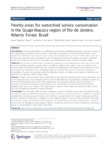Please use this identifier to cite or link to this item:
http://www.alice.cnptia.embrapa.br/alice/handle/doc/992454| Title: | Priority areas for watershed service conservation in the Guapi-Macacu region of Rio de Janeiro, Atlantic Forest, Brazil. |
| Authors: | RODRÍGUEZ OSUNA, V.  BÖRNER, J.   NEHREN, U.   PRADO, R. B.   GAESE, H.   HEINRICH, J.   |
| Affiliation: | Vanesa Rodríguez Osuna, Department of Economic and Technological; Jan Börner, Department of Economic and Technological Change; Udo Nehren, Institute for Technology and Resources Management in the Tropics and Subtropics; RACHEL BARDY PRADO, CNPS; Hartmut Gaese, Department of Economic and Technological Change; Jürgen Heinrich, Institute for Geography, Department of Physical Geography, University of Leipzig. |
| Date Issued: | 2014 |
| Citation: | Ecological Processes, v. 3, n. 16, 2014. |
| Description: | Introduction: Land use intensification and urbanisation processes are degrading hydrological ecosystem services in the Guapi-Macacu watershed of Rio de Janeiro. A proposal to pay farmers to restore natural watershed services might be an alternative to securing the water supply in the long-term for the around 2.5 million urban water users in the study region. This study quantifies the costs of changing current land use patterns to enhance watershed services and compares these costs to the avoided costs associated with water treatment for public supply. Methods: We use farm-household data to estimate the opportunity costs of abandoning current land uses for the recovery of natural vegetation; a process that is very likely to improve water quality in terms of turbidity due to reduced inputs from erosion. Opportunity cost estimates are extrapolated to the watershed scale based on remote sensing land use classifications and vulnerability analysis to identify priority zones for watershed management interventions. To assess the potential demand for watershed services, we analyse water quality and treatment cost data from the main local water treatment plant. Results: Changing agricultural land uses for watershed services provision generally comes at high opportunity costs in our study area near to the metropolis of Rio de Janeiro. Alternative low cost watershed conservation options do exist in the livestock production sector. These options have the potential to directly reduce the amount of sediments and nutrients reaching the water bodies, and in turn decrease the costs of treatment needed for drinking water. Land cover changes at the scale needed to improve water quality will, nonetheless, likely exceed the cost of additional investments in water treatment. Conclusions: The state water utility company?s willingness to pay for watershed services alone will not be enough to induce provision of additional watershed services. We conclude that monetary incentives conditioned on specific adjustments to existing production systems could still have a complementary role to play in improving watershed services. However, we note that our willingness to pay analysis focusses on only one of the potentially wide range of ecosystem services provided by natural vegetation in the Guapi-Macacu watershed. Factoring these ecosystem services into the willingness to pay equation is likely to change our assessment in favour of additional conservation action, be it through PES or other policy instruments. |
| Thesagro: | Qualidade da Água |
| NAL Thesaurus: | water quality |
| Keywords: | Water services Drinking water treatment Incentive-based watershed managemenT Serviços de água Tratamento de água potável Gestão de bacias hidrográficas baseada em incentivos |
| DOI: | 10.1186/s13717-014-0016-7 |
| Type of Material: | Artigo de periódico |
| Access: | openAccess |
| Appears in Collections: | Artigo em periódico indexado (CNPS)  |
Files in This Item:
| File | Description | Size | Format | |
|---|---|---|---|---|
| s1371701400167.pdf | 2.01 MB | Adobe PDF |  View/Open |









